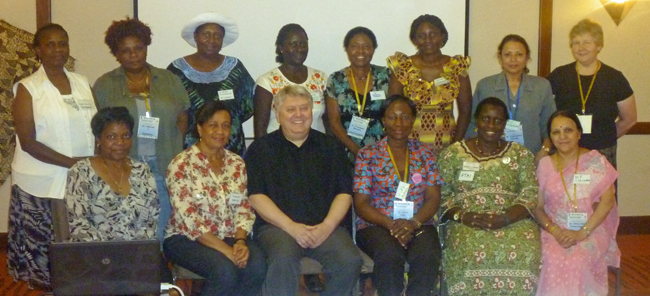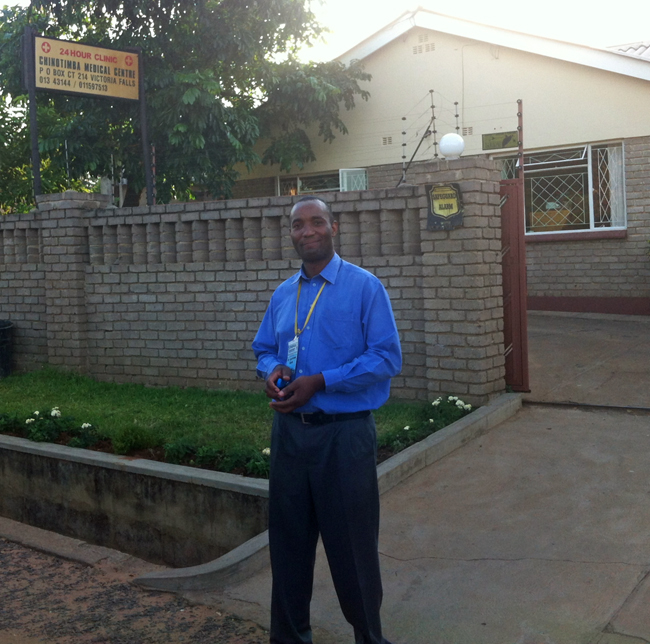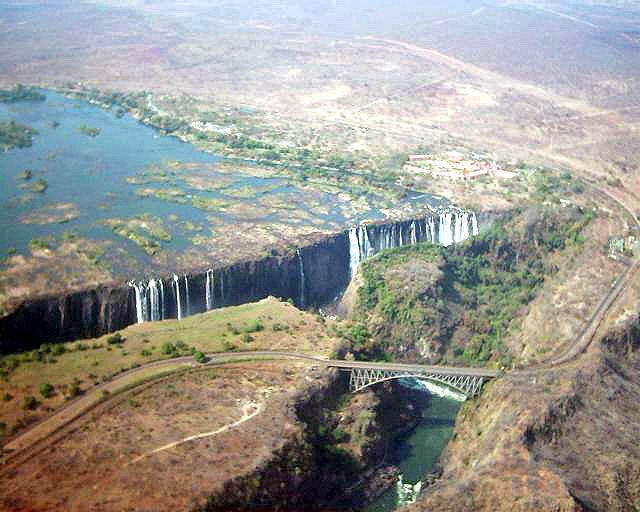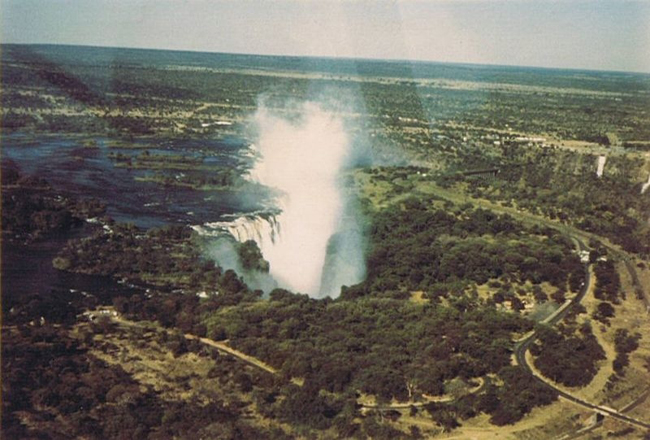From the President: Africa Rising
español
“Where are the mist and thunder?” Those were the first words that came to mind as I looked across the treetops toward Victoria Falls, one kilometer to the north. Mosi-oa-Tunya (“The Smoke that Thunders”) is one of the natural wonders of the world. Formed by a crack in the basalt table over which flows the Zambezi River, Vic Falls is said to be the largest sheet of falling water in the world. It has become an important source of income from tourism and conferences for cash-starved Zimbabwe.
I had traveled a long distance to attend the WONCA Africa regional conference and to see the Falls. I came prepared to be impressed by the Falls, but all I could see from my hotel on a distant hill was a flat plain covered with brown trees. That initial disappointment caused me to worry that my high expectations for the conference were also at risk. I learned however, during my week in Zimbabwe, that first impressions can be misleading. One needs to look closer and deeper to see the true nature and value of things.
This was the third conference of the African region, with the previous two in 2000 (Abuja, Nigeria) and 2009 (Rustenberg, South Africa). In the year leading up to the conference, there were some who doubted that the meeting would, or could, actually be convened in Zimbabwe. Those doubters were proved wrong. Hosted by the College of Primary Care Physicians of Zimbabwe (CPCPZ), the conference was an extraordinary success. Nearly 400 delegates attended from 25 countries, 15 of them African. The success was due to the hard work of Dr Muriel Fallala (convenor) and Mrs Neriser Sibanda (secretariat), along with their colleagues on the Local Organizing and Scientific Committees.
 Prof Rich Roberts - the thorn amidst a bouquet of flowers
Prof Rich Roberts - the thorn amidst a bouquet of flowers
The educational sessions were a mix of broad plenary lectures combined with more specific workshops. While the speakers represented many countries, it was wonderful to have most from Africa. The sessions were well attended and stimulated vigorous discussion. Most memorable for me were two plenary sessions. One was on the links between the economy, health, and Family Medicine in Zimbabwe by Dr Billy Rigava, Vice President of the CPCPZ. The other was a rousing oratory on the congruence between the values of Africa and Family Medicine by Dr Atai Omoruto of Uganda. The social events provided excellent networking opportunities and a taste of African culture and cuisine.
Along with several others, I was able to visit the practice of Dr Kurai Ngaribvume, the only private practice in the area. Dr Kurai had been the District Medical Officer (DMO) in Vic Falls before opening the Chinotimba Medical Centre. Located in a residential neighborhood, his building was well appointed and included a birthing room where he and his nurse attended about 10 births per month. He performed ultrasound as needed. When operative intervention was required, he would do the cesarean at the district hospital several kilometers away. Patients with medical conditions were sometimes observed overnight in the clinic, such as when requiring intravenous fluids. He has plans to expand the facility to include x-ray and laboratory services.
 Dr Kurai Ngaribvume at his clinic
Dr Kurai Ngaribvume at his clinic
Dr Kurai and his patients also kindly consented to our observing their consultations. One was a man who was a successful manager and described hematochezia, likely related to alcohol use. Another was a woman who was positive for HIV and complained of nasal allergy symptoms. While addressing her primary concern, Dr Kurai also skillfully nudged her toward obtaining a CD4 count and resuming use of her anti-retroviral (ARV) treatment, which she had discontinued some months earlier. A young boy presented with balanitis and reactive adenopathy. In each case, Dr Kurai demonstrated the attributes I have seen in so many skilled family doctors around the world: person-centered; sensitive to family, culture, and community issues; practical; efficient; and empathic.
My visit to Vic Falls was another reminder of the gap that often exists between our assumptions and our subsequent experience. My assumption was that Zimbabwe was a dangerous place consumed by fractious politics. My experience was that the Zimbabweans were some of the friendliest people I have encountered. Politics were not a burning topic of conversation.
My assumption was that Zimbabwe was a very poor country with a failed economy. Indeed, Dr Rigava described the previous decade when there was a 94% unemployment rate for the formal economy with 93% of the population lacking access to the formal health care sector. Gross domestic product (GDP) dropped 54% by 2008, to an average per capita income of $340, less than 1USD per day. Yet, I was not aware that income had nearly doubled to $640 since. Much of that growth appears to be due to Chinese investment related to mining and other natural resources. While Zimbabwe remains a low income country, there was a sense of optimism among those who had survived very difficult times. Another irony that I have experienced many places is that those who are most deprived economically often seem to be most generous in spirit.
Shortly after independence, Zimbabwe made impressive gains in health status indicators by adopting a primary health care model. Many of those gains were lost when the public health system collapsed during the difficult decade. As things improve, the Zimbabweans are rebuilding their system through thoughtful efforts to better link primary health care and public health. The importance of such linkages is reflected in the selection of two family doctors as recent health ministers of Zimbabwe, including the current minister Dr Henry Modzorera. He gave a moving talk highlighting the important connections between social determinants and health status.
Make no mistake. Zimbabwe has a long way to go. Their need for health professionals is substantial, with the number of doctors and nurses at 2 and 9 per 10,000 people, respectively. Many high income countries have 10-20 times those numbers. These differences show themselves in the health outcomes experienced by Zimbabweans. Sadly, with a maternal mortality rate of 570 per 100,000 births, Zimbabwe’s mothers die at 100 times the rate of high income countries and even 10 times the rate of relatively low income countries such as Thailand. At the same time, it was encouraging to learn that the many stakeholders involved in health care in Zimbabwe are making conscious efforts to work together to improve the health of the people. The status of Family Medicine as a recognized and respected discipline is on the rise. Through distance learning programs like the Stellenbosch Master’s in Family Medicine in neighboring South Africa, Zimbabwe is gradually increasing its capacity of qualified family doctors.
During the course of the conference, innovative strategies were presented to improve the distribution and quality of family doctors in Africa, such as the Rural Doctors Support Programme in South Africa. Another example was the Family Medicine Specialty Training Program in Lesotho, which is built on a continuous quality improvement approach. These examples and others give me hope that there are better days ahead for Africa.
Some have described the 20th century as the century of America, with this being the century of China and India. My belief is that in the near future it will be the time of Africa. Its young demographics, natural resources, and traditions of communal sharing and ingenious improvisation to offset limited resources all position Africa to be a dynamic and global leader in the future. I also believe that similar advances will happen in African health care. Limited resources force countries to focus on priorities and address important needs. In contrast, clinical service and research agendas in high income countries often lose creativity, flexibility, and relevance as they get tangled up in excessive bureaucracies, entrenched interests, and wasteful practices.
 Victoria Falls - dry & wet seasons (Photos from Wikipedia)
Victoria Falls - dry & wet seasons (Photos from Wikipedia)

My assumption that I was going to see the spray of Vic Falls above the tree canopy was unrealistic in the face of the two year drought the area has suffered. After a 30 minute walk afforded me a closer inspection, my experience was that the Falls were more beautiful than I expected. The lower water levels made for a more interesting waterfall than one could imagine, with all the minor gorges and islands now visible. I know that one day soon the rains will return and swell the Zambezi River with water, once again lifting the mist of the Falls above the tree line. Like the Smoke that Thunders, I believe we will be impressed and inspired as we watch Africa rising. Go and see for yourself.
Professor Richard Roberts
President
World Organization of Family Doctors